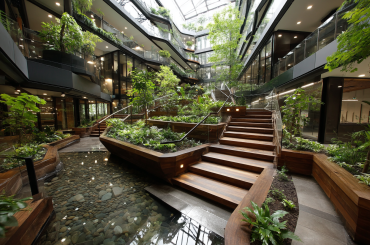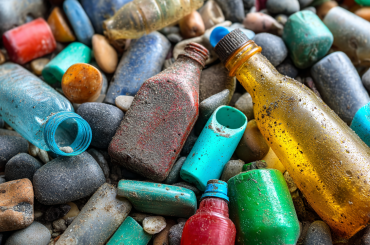The package arrived on a drizzly Tuesday morning, wrapped in what looked like green plastic but with an odd, almost papery texture. “Seaweed packaging,” explained the note inside. “Dissolve in hot water or compost within 4-6 weeks.” Intrigued, I filled my kitchen sink with hot water and dropped in the wrapping, which proceeded to disappear before my eyes like some kind of magician’s trick. Within three minutes, nothing remained but slightly cloudy water that—according to the instructions—was perfectly safe to pour on my houseplants as a mild fertilizer. I stood there, slightly stunned, holding a sustainable sweater that had arrived in packaging that had literally just dissolved into plant food.
This was my first personal encounter with algae-based materials, but it certainly wouldn’t be my last. That dissolving packaging was made from brown seaweed (macroalgae) processed into a film that behaved like plastic but was completely biodegradable and actually beneficial at end-of-life. It was a perfect introduction to the weird and wonderful world of algae materials—a field that might sound niche but is rapidly emerging as one of our most promising paths toward a truly circular economy.
When most people hear “algae,” they picture either the green scum on neglected ponds or perhaps the seaweed in their sushi. Few imagine it as the source of their next water bottle, running shoes, or building insulation. Yet these humble organisms—ranging from microscopic single-celled species to massive kelp forests—are being transformed into an astonishing array of sustainable materials with properties that sometimes surpass their conventional, environmentally problematic counterparts.
My journey into algae-based materials began professionally rather than personally. I was researching alternatives to single-use plastics for a feature article when I stumbled across a small startup creating food containers from red algae. What caught my attention wasn’t just the material’s biodegradability (though that was impressive), but the founder’s offhand comment that their production process actually absorbed carbon rather than emitting it. In an era where we’re desperately trying to reduce carbon emissions, the idea of materials that sequester carbon during manufacturing seemed almost too good to be true.
Intrigued, I arranged a visit to their pilot facility—essentially a converted warehouse space filled with what looked like brewing equipment and drying racks. Lucy, the founder, met me wearing rubber boots and a lab coat with suspicious green stains across the front. “We’re having some growth parameter issues today,” she explained cheerfully, gesturing to a tank bubbling with what looked like very green soup. “The challenge with living manufacturing systems is they have opinions about their working conditions.”
That perspective—seeing algae cultivation as collaborating with living systems rather than simply extracting resources—runs throughout the field. Unlike conventional material production which typically follows a linear extract-produce-dispose model, algae materials start with organisms that can be continuously grown using sunlight, carbon dioxide, and nutrients that would otherwise be pollutants. It’s manufacturing that functions more like an ecosystem than an assembly line.
The environmental advantages border on the ridiculous when compared to conventional materials. Many algae species grow incredibly quickly—some can double their biomass in as little as six hours. They don’t require freshwater, agricultural land, pesticides, or herbicides. They actively consume CO2 rather than producing it. Many species can be grown in polluted water, actually cleaning it in the process. And the resulting materials are typically biodegradable or even compostable, returning safely to natural systems at end of life. It’s about as close to a circular material as we’ve managed to create.
“The biggest challenge isn’t growing enough algae,” Lucy explained as she showed me around. “It’s figuring out how to process it efficiently and consistently at scale.” She handed me samples of their containers in various stages of development—some flexible like conventional plastic, others more rigid, all with a slightly textured surface that hinted at their biological origins. “We’re not trying to create perfect imitations of plastic. We’re trying to create something better that happens to serve the same functions.”
That sentiment echoes throughout the algae materials sector. Rather than simply mimicking existing materials with all their existing limitations, many innovators are leveraging algae’s unique properties to create new materials with additional benefits. The packaging that dissolves into plant food is a perfect example—why simply be non-harmful at end of life when you can actually be beneficial?
Since that initial introduction, I’ve encountered algae-based materials in increasingly surprising applications. There are now companies producing trainers with algae-based foam that’s both more cushioning and more durable than conventional EVA foam. Building materials made from algae offer excellent insulation properties while improving indoor air quality. Textiles derived from certain seaweeds can naturally inhibit bacterial growth, making them ideal for sportswear. Some algae-based bioplastics are not just biodegradable but edible—though I can confirm from personal experience that they don’t taste particularly good. (The startup founder who offered me a sample of their “edible six-pack rings” neglected to mention they hadn’t quite worked out the flavor profile yet. Think extremely seaweed-forward chewing gum with notes of fish tank.)
The diversity of applications stems from the remarkable diversity of algae themselves. With somewhere between 30,000 and a million species (scientists still debate the exact number), they offer a vast biological library of potential properties and compounds. Some species produce oils similar to petroleum. Others create complex carbohydrates with unique structural properties. Some generate natural pigments that can replace synthetic dyes. The field feels less like a single material category and more like an entirely new approach to material science—one based on biological processes rather than petrochemical ones.
Dr. Mohammed Hasan at Imperial College London has been studying algae materials for over a decade. When I interviewed him for my initial article, he explained the paradigm shift these materials represent. “For two centuries, we’ve built our material economy on breaking down ancient carbon deposits—fossil fuels—into building blocks we reassemble into materials that don’t fit into natural cycles. With algae, we’re working with living systems that naturally create complex, functional materials using current atmospheric carbon. It’s the difference between spending from a finite savings account and generating renewable income.”
Of course, algae materials aren’t without challenges. Many current production methods remain energy-intensive or rely on chemical processes that undermine some of the sustainability benefits. Consistency can be difficult with biological systems influenced by countless variables. And scaling production to truly commercial levels requires significant investment in new infrastructure and processes.
Then there’s the “yuck factor” that still affects some consumers’ perceptions. When I mentioned working on this article to my friend Ruth, she made a face. “You mean like pond scum? That sounds absolutely disgusting on my skin.” I reminded her that she happily pays premium prices for seaweed face masks and regularly eats algae in her sushi, which somewhat undermined her disgust. But the perception issue is real—”algae-based” doesn’t yet have the same marketing appeal as, say, “bamboo” or “organic cotton,” despite often having superior environmental credentials.
To better understand the current state of the field, I visited several companies working with algae materials across different sectors. At a facility in Scotland, I watched massive tanks of microalgae being cultivated to produce bioplastics for food packaging. In a London design studio, I handled luxurious textiles made from kelp that felt remarkably similar to silk but could decompose in soil within weeks. At a green building expo, I walked through a room insulated with algae-based panels that were not only capturing carbon but actively purifying the air.
The most compelling visit was to a small surfboard workshop on the Cornwall coast, where Sam, a lifelong surfer with environmental science training, had developed a surfboard foam from algae rather than the conventional polyurethane. “Surfing culture is all about connection with the ocean,” he explained as he showed me the production process. “But our equipment has been actively harming the environments we love. It made no sense.”
His algae boards were indistinguishable in performance from conventional ones but biodegraded safely at end of life. More importantly, they actually sequestered carbon during production. “Each board locks away about 2kg of carbon dioxide,” he told me proudly. “Not a massive amount individually, but multiply that across the industry and it starts to matter. And unlike carbon capture technology, you get a functional product in the bargain.”
The economics of algae materials are steadily improving as production scales up and processes are refined. Many algae-based alternatives remain more expensive than their conventional counterparts, but the gap is narrowing—particularly when considering full lifecycle costs including disposal. Some applications have already achieved price parity, especially in premium markets where sustainability commands value. And the possibility of carbon credits for materials that sequester carbon could further shift the economic equation.
For consumers interested in supporting the development of these materials, options are increasingly available across product categories. Footwear brands like Vivobarefoot and Bloom have incorporated algae-based foams into their shoes. Companies like Notpla offer food packaging derived from seaweed. Clothing makers including Pangaia and Vollebak have released garments incorporating algae-based dyes and materials. Building material companies like Algix provide algae-based alternatives for construction applications. None of these are yet mainstream, but they’re available to consumers willing to seek them out.
What excites me most about algae materials isn’t just their environmental benefits, impressive as those are. It’s the fundamental shift they represent in how we think about manufacturing. Rather than the industrial approach of “heat, beat, and treat”—applying energy and chemicals to force materials into submission—algae production often works with biological processes that have evolved over billions of years. It’s a more collaborative, less dominating relationship with the materials we use.
This approach extends to end-of-life considerations as well. When I composted a sample of algae-based packaging in my kitchen scraps bin, it broke down faster than the vegetable waste surrounding it. I found something deeply satisfying about a material that so gracefully returns to the systems it came from—no microplastics, no toxic residues, no persistent waste.
The field remains young, with many technical challenges still to overcome. But the trajectory is clear and promising. Ten years ago, algae materials were largely theoretical or existed only in laboratories. Today, I can purchase products made from them with a few clicks. The scaling happening now suggests that ten years from now, they may be commonplace across multiple sectors—not just niche sustainable alternatives but mainstream options chosen for performance as much as environmental benefits.
I’ve kept the sweater that arrived in that dissolving seaweed packaging. It’s nothing special in itself—just a basic organic cotton pullover—but it reminds me of that moment of watching packaging simply disappear, solving its own waste problem. There was something almost magical about it, a glimpse of a different possible relationship with the materials that pass through our lives.
That magic, I think, is what drives many of the scientists and entrepreneurs in this field. Lucy from the packaging startup put it beautifully when I asked why she’d left a lucrative chemical engineering career to struggle with temperamental algae cultures. “In conventional materials, success means something that doesn’t change or break down—permanence is the goal,” she said. “With algae materials, we’re embracing materials that change, that respond to their environment, that eventually return to it. There’s something profound about creating things that are designed to be part of larger cycles rather than exceptions to them.”
As I left her facility that day, she handed me a small container made from their latest formulation. “Put some soil and seeds in it and watch what happens,” she suggested with a smile. Two weeks later, the container had started to soften around the edges as the seedlings pushed through, the material gradually becoming food for the very plants it had initially protected. I took a picture and sent it to Lucy with the caption: “Now THIS is packaging with purpose.” Her response came back immediately: “Just wait until you see what we’re working on next.”
Knowing the field’s rapid development, I absolutely can’t wait to find out.









